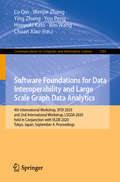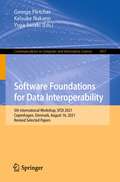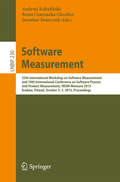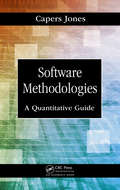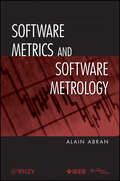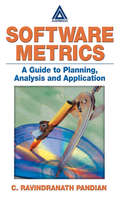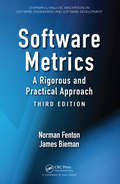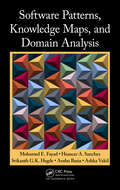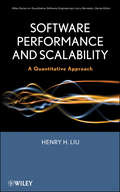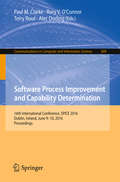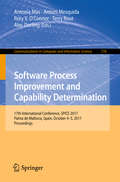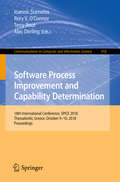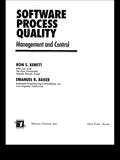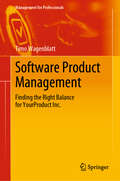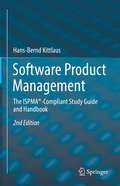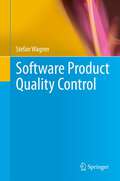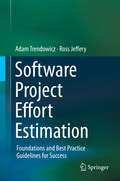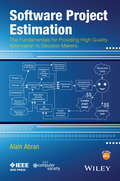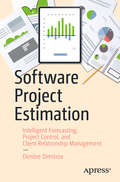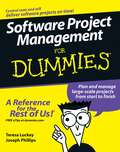- Table View
- List View
Software Foundations for Data Interoperability and Large Scale Graph Data Analytics: 4th International Workshop, SFDI 2020, and 2nd International Workshop, LSGDA 2020, held in Conjunction with VLDB 2020, Tokyo, Japan, September 4, 2020, Proceedings (Communications in Computer and Information Science #1281)
by Wei Wang Ying Zhang Lu Qin Wenjie Zhang You Peng Hiroyuki Kato Chuan XiaoThis book constitutes refereed proceedings of the 4th International Workshop on Software Foundations for Data Interoperability, SFDI 2020, and 2nd International Workshop on Large Scale Graph Data Analytics, LSGDA 2020, held in Conjunction with VLDB 2020, in September 2020. Due to the COVID-19 pandemic the conference was held online. The 11 full papers and 4 short papers were thoroughly reviewed and selected from 38 submissions. The volme presents original research and application papers on the development of novel graph analytics models, scalable graph analytics techniques and systems, data integration, and data exchange.
Software Foundations for Data Interoperability: 5th International Workshop, SFDI 2021, Copenhagen, Denmark, August 16, 2021, Revised Selected Papers (Communications in Computer and Information Science #1457)
by George Fletcher Keisuke Nakano Yuya SasakiThis book constitutes selected papers presented at the 5th International Workshop on Software Foundations for Data Interoperability, SFDI 2021, held in Copenhagen, Denmark, in August 2021. The 4 full papers and one short paper were thorougly reviewed and selected from 8 submissions. They present discussions in research and development in software foundations for data interoperability as well as the applications in real-world systems such as data markets.
Software Life Cycle Management Standards
by David WrightThe advent of ISO/IEC 19770 is a leap forward for all who have an interest in the software life cycle, from designer to consumer. In five parts, three of which are still under development, the Standard defines best practice for all aspects of software asset management and introduces SWID (software identification) tags and SWEID (software licensing entitlement) tags. Software Publishers - your route to financial rewards This book will guide you along the implementation path by: defining each part of ISO/IEC 19770 and what each one means for your business discussing the software life cycle from the perception of all parties involved showing you how the SWID and SWEID tagging systems will help you obtain vital information about your customers software needs and usage helping you meet those needs and, consequently, enjoy increased customer loyalty, leading to more sales! showing you how the Standard can help you fine-tune your processes helping you realize financial savings.
Software Maintenance Success Recipes
by Donald J. ReiferSoftware Maintenance Success Recipes identifies actionable formulas for success based on in-depth analysis of more than 200 real-world maintenance projects. It details the set of factors that are usually present when effective software maintenance teams do their work and instructs on the methods required to achieve success. Donald J. Reifer-an award winner for his contributions to the field of software engineering-provides step-by-step guidance on how to structure the job to complete all of the work related to the task.
Software Measurement
by Andrzej Kobyliński Beata Czarnacka-Chrobot Jarosław ŚwierczekThis book constitutes the refereed proceedings of two joint events: the 25th International Workshop on Software Measurement (IWSM) and the 10th International Conference on Software Process and Product Measurement (Mensura), referred to as IWSMâe Mensura 2015 and held in Kraków, Poland, in October 2015. Software measurement is a key methodology in estimating, managing, and controlling software development and management projects. The 13 papers presented in this volume were carefully reviewed and selected from 32 submissions. They present various theoretical and empirical results related to software measurement and its application in industrial projects.
Software Methodologies: A Quantitative Guide
by Capers JonesThis comprehensive reference uses a formal and standard evaluation technique to show the strengths and weakness of more than 60 software development methodologies such as agile, DevOps, RUP, Waterfall, TSP, XP and many more. Each methodology is applied to an application of 1000 function points using the Java language. Each methodology produces a characteristic set of results for development schedules, productivity, costs, and quality. The intent of the book is to show readers the optimum kinds of methodologies for the projects they are concerned with and to warn them about counter indications and possible harm from unsuitable methodologies.
Software Metrics and Software Metrology
by Alain AbranMost of the software measures currently proposed to the industry bring few real benefits to either software managers or developers. This book looks at the classical metrology concepts from science and engineering, using them as criteria to propose an approach to analyze the design of current software measures and then design new software measures (illustrated with the design of a software measure that has been adopted as an ISO measurement standard). The book includes several case studies analyzing strengths and weaknesses of some of the software measures most often quoted. It is meant for software quality specialists and process improvement analysts and managers.
Software Metrics: A Guide to Planning, Analysis, and Application
by C. Ravindranath PandianThe modern field of software metrics emerged from the computer modeling and "statistical thinking" services of the 1980s. As the field evolved, metrics programs were integrated with project management, and metrics grew to be a major tool in the managerial decision-making process of software companies. This book simplifies software measurement and explains its value as a tool for decision-makers at software companies. Techniques presented in Software Metrics: A Guide to Planning, Analysis, and Application are derived from best practices. The ideas are field-proven, down-to-earth, and straightforward, making it an invaluable resource for those striving for process improvement. This overview helps readers enrich their knowledge of measurements, analysis, and best practices, and demonstrates how ordinary analysis techniques can be applied to achieve extraordinary results. Easy-to-understand tools and techniques show how metrics create models that are indispensable to decision-making in the software industry.
Software Metrics: A Rigorous and Practical Approach, Third Edition (Chapman & Hall/CRC Innovations in Software Engineering and Software Development Series)
by Norman Fenton James BiemanA Framework for Managing, Measuring, and Predicting Attributes of Software Development Products and ProcessesReflecting the immense progress in the development and use of software metrics in the past decades, Software Metrics: A Rigorous and Practical Approach, Third Edition provides an up-to-date, accessible, and comprehensive introduction to soft
Software Mistakes and Tradeoffs: How to make good programming decisions
by Tomasz Lelek Jon SkeetOptimize the decisions that define your code by exploring the common mistakes and intentional tradeoffs made by expert developers. In Software Mistakes and Tradeoffs you will learn how to: Reason about your systems to make intuitive and better design decisions Understand consequences and how to balance tradeoffs Pick the right library for your problem Thoroughly analyze all of your service&’s dependencies Understand delivery semantics and how they influence distributed architecture Design and execute performance tests to detect code hot paths and validate a system&’s SLA Detect and optimize hot paths in your code to focus optimization efforts on root causes Decide on a suitable data model for date/time handling to avoid common (but subtle) mistakes Reason about compatibility and versioning to prevent unexpected problems for API clients Understand tight/loose coupling and how it influences coordination of work between teams Clarify requirements until they are precise, easily implemented, and easily tested Optimize your APIs for friendly user experience Code performance versus simplicity. Delivery speed versus duplication. Flexibility versus maintainability—every decision you make in software engineering involves balancing tradeoffs. In Software Mistakes and Tradeoffs you&’ll learn from costly mistakes that Tomasz Lelek and Jon Skeet have encountered over their impressive careers. You&’ll explore real-world scenarios where poor understanding of tradeoffs lead to major problems down the road, so you can pre-empt your own mistakes with a more thoughtful approach to decision making. Learn how code duplication impacts the coupling and evolution speed of your systems, and how simple-sounding requirements can have hidden nuances with respect to date and time information. Discover how to efficiently narrow your optimization scope according to 80/20 Pareto principles, and ensure consistency in your distributed systems. You&’ll soon have built up the kind of knowledge base that only comes from years of experience. About the technology Every step in a software project involves making tradeoffs. When you&’re balancing speed, security, cost, delivery time, features, and more, reasonable design choices may prove problematic in production. The expert insights and relatable war stories in this book will help you make good choices as you design and build applications. About the book Software Mistakes and Tradeoffs explores real-world scenarios where the wrong tradeoff decisions were made and illuminates what could have been done differently. In it, authors Tomasz Lelek and Jon Skeet share wisdom based on decades of software engineering experience, including some delightfully instructive mistakes. You&’ll appreciate the specific tips and practical techniques that accompany each example, along with evergreen patterns that will change the way you approach your next projects. What's inside How to reason about your software systematically How to pick tools, libraries, and frameworks How tight and loose coupling affect team coordination Requirements that are precise, easy to implement, and easy to test About the reader For mid- and senior-level developers and architects who make decisions about software design and implementation. About the author Tomasz Lelek works daily with a wide range of production services, architectures, and JVM languages. A Google engineer and author of C# in Depth, Jon Skeet is famous for his many practical contributions to Stack Overflow.
Software Patterns, Knowledge Maps, and Domain Analysis
by Mohamed E. Fayad Huascar A. Sanchez Srikanth G.K. Hegde Anshu Basia Ashka VakilSoftware design patterns are known to play a vital role in enhancing the quality of software systems while reducing development time and cost. However, the use of these design patterns has also been known to introduce problems that can significantly reduce the stability, robustness, and reusability of software. This book introduces a new process fo
Software Performance and Scalability: A Quantitative Approach
by Henry H. LiuThe Basics -introduces the computer hardware and software architectures that predetermine the performance and scalability of a software product as well as the principles of measuring the performance and scalability of a software product Queuing Theory -helps you learn the performance laws and queuing models for interpreting the underlying physics behind software performance and scalability, supplemented with ready-to-apply techniques for improving the performance and scalability of a software system API Profiling -shows you how to design more efficient algorithms and achieve optimized performance and scalability, aided by adopting an API profiling framework (perfBasic) built on the concept of a performance map for drilling down performance root causes at the API level Software Performance and Scalability gives you a specialized skill set that will enable you to design and build performance into your products with immediate, measurable improvements. Complemented with real-world case studies, it is an indispensable resource for software developers, quality and performance assurance engineers, architects, and managers. It is anideal text for university courses related to computer and software performance evaluation and can also be used to supplement a course in computer organization or in queuing theory for upper-division and graduate computer science students.
Software Process Definition and Management
by Martin Kowalczyk Jürgen Münch Martín Soto Ove ArmbrustThe concept of processes is at the heart of software and systems engineering. Software process models integrate software engineering methods and techniques and are the basis for managing large-scale software and IT projects. High product quality routinely results from high process quality. Software process management deals with getting and maintaining control over processes and their evolution. Becoming acquainted with existing software process models is not enough, though. It is important to understand how to select, define, manage, deploy, evaluate, and systematically evolve software process models so that they suitably address the problems, applications, and environments to which they are applied. Providing basic knowledge for these important tasks is the main goal of this textbook. Münch and his co-authors aim at providing knowledge that enables readers to develop useful process models that are suitable for their own purposes. They start with the basic concepts. Subsequently, existing representative process models are introduced, followed by a description of how to create individual models and the necessary means for doing so (i.e., notations and tools). Lastly, different possible usage scenarios for process management are highlighted (e.g. process improvement and software process simulation). Their book is aimed at students and researchers working on software project management, software quality assurance, and software measurement; and at practitioners who are interested in process definition and management for developing, maintaining, and operating software-intensive systems and services.
Software Process Improvement and Capability Determination
by Paul M. Clarke Rory V. O'Connor Terry Rout Alec DorlingThis book constitutes the refereed proceedings of the 16th International Conference on Software Process Improvement and Capability Determination, SPICE 2016, held in Dublin, Ireland, in June 2016. The 28 full papers presented together with 5 short papers were carefully reviewed and selected from 52 submissions. The papers are organized in the following topical sections: SPI in regulated and safety critical domains; gamification and education issues in SPI; SPI in agile and small settings; SPI and assessment; SPI and project management concerns; empirical research case studies of SPI; knowledge and human communications issues in SPI.
Software Process Improvement and Capability Determination
by Rory V. O'Connor Terry Rout Alec Dorling Antonia Mas Antoni MesquidaThe SPICE (Software Process Improvement and Capability dEtermination) Project is a joint effort by the ISO and IEC to create an international standard for software process assessment. This book covers both the theory of SPICE and its practical applications, including the lessons learned from the SPICE trials. It includes a valuable automated tool on CD-ROM to help you apply the concepts presented in the book. The text shows the evolution of the most recent developments in the SPICE project. It documents the major products and the empirical evaluations that have been conducted thus far. The book is jointly written by the key experts involved in the SPICE project. The theory chapters describe the rationale behind the architecture and the contents of the V1. 0 and V2. 0 document set and how to interpret them. The remaining chapters describe the applications and how that make use of the theory behind them.
Software Process Improvement and Capability Determination: 18th International Conference, SPICE 2018, Thessaloniki, Greece, October 9–10, 2018, Proceedings (Communications in Computer and Information Science #918)
by Ioannis Stamelos Rory V. O'Connor Terry Rout Alec DorlingThis volume constitutes the refereed proceedings of the 18th International Conference on Software Process Improvement and Capability Determination, SPICE 2018, held in Tessaloniki, Greece, in October 2018. The 26 full papers presented were carefully reviewed and selected from 40 submissions. The papers are organized in the following topical sections: SPI systematic literature reviews; SPI and assessment; SPI methods and reference models; SPI education and management issues; SPI knowledge and change processes; SPI compliance and configuration; SPI and agile; industry short papers.
Software Process Quality: Management and Control
by Ron S. Kenett Emanuel BakerUsing actual examples of software process improvement from the private sector and government, this work demonstrates how quality systems, measurement techniques and performance evaluations work. It presents a methodology for analyzing an ongoing software development process and establishing a rational plan for process improvement.
Software Product Management
by Samuel A. Fricker Hans-Bernd KittlausThis book gives a comprehensive overview on Software Product Management (SPM) for beginners as well as best practices, methodology and in-depth discussions for experienced product managers. This includes product strategy, product planning, participation in strategic management activities and orchestration of the functional units of the company. The book is based on the results of the International Software Product Management Association (ISPMA) which is a group of SPM experts from industry and research with the goal to foster software product management excellence across industries. ISPMA is focused on establishing software product management as a discipline of its own in both academia and industry. It disseminates and maintains a curriculum and a certifiable body of knowledge (SPMBoK). This book can be used as textbook for ISPMA-based education and as guide for anybody interested in SPM as one of the most exciting disciplines in the business of software.
Software Product Management: Finding the Right Balance for YourProduct Inc. (Management for Professionals)
by Timo WagenblattThis book is for product managers, product owners, product marketing managers, VPs and Heads of Product, CEOs, and start-up founders. In short, it serves anyone interested personally or professionally in software product management. You’ll learn how to plan, coordinate and execute all activities required for software product success. It enables you to find the right balance for delivering customer value and long-term product success.The book offers a comprehensive introduction for beginners as well as proven practices and a novel, holistic approach for experienced product managers. It provides much-needed clarity regarding the numerous tasks and responsibilities involved in the professional and successful management of software products. Readers can use this book as a reference book if they are interested in or have the urgent need to improve one of the following software product management dimensions: Product Viability, Product Development, Go-to-Market / Product Marketing, Software Demonstrations and Training, The Market / Your Customers, or Organizational Maturity.The book helps product people to maximize their impact and effectiveness. Whether you’re a seasoned practitioner, new to software product management, or just want to learn more about the best-of-all disciplines and advance your skills, this book introduces a novel and “business” tested approach to structure and orchestrate the vital dimensions of software product management. You will learn how to create focus and alignment on the things that matter for product success.The book describes a holistic framework to keep the details that matter for product success in balance, taking into consideration the limiting factors, strategies and responsibilities that determine the overall product yield potential. It explains how to leverage and adapt the framework with regard to aspects like product viability, product development, product marketing and software demonstrations and training, as well as more general aspects like markets, customers and organizational maturity.The book focuses on the unique challenges of software product managers or any related roles, whether you are a founder of a small to mid-sized software company or working in the complex ecosystems of large software enterprises or corporate IT departments.
Software Product Management: The ISPMA®-Compliant Study Guide and Handbook
by Hans-Bernd KittlausSoftware Product Management (SPM) is a key success factor for software products and software-intensive products. This book gives a comprehensive overview on SPM for beginners as well as best practices, methodology and in-depth discussions for experienced product managers. This includes product strategy, product planning, participation in strategic management activities and orchestration of the functional units of the company. The book is based on the results of the International Software Product Management Association (ISPMA®, SPM Body of Knowledge V.2) which is led by a group of SPM experts from industry and research with the goal to foster software product management excellence across industries. This book can be used as textbook for ISPMA®-based education and as guide for anybody interested in SPM as one of the most exciting and challenging disciplines in the business of software.
Software Product Quality Control
by Stefan WagnerQuality is not a fixed or universal property of software; it depends on the context and goals of its stakeholders. Hence, when you want to develop a high-quality software system, the first step must be a clear and precise specification of quality. Yet even if you get it right and complete, you can be sure that it will become invalid over time. So the only solution is continuous quality control: the steady and explicit evaluation of a product's properties with respect to its updated quality goals. This book guides you in setting up and running continuous quality control in your environment. Starting with a general introduction on the notion of quality, it elaborates what the differences between process and product quality are and provides definitions for quality-related terms often used without the required level of precision. On this basis, the work then discusses quality models as the foundation of quality control, explaining how to plan desired product qualities and how to ensure they are delivered throughout the entire lifecycle. Next it presents the main concepts and techniques of continuous quality control, discussing the quality control loop and its main techniques such as reviews or testing. In addition to sample scenarios in all chapters, the book is rounded out by a dedicated chapter highlighting several applications of different subsets of the presented quality control techniques in an industrial setting. The book is primarily intended for practitioners working in software engineering or quality assurance, who will benefit by learning how to improve their current processes, how to plan for quality, and how to apply state-of-the-art quality control techniques. Students and lecturers in computer science and specializing in software engineering will also profit from this book, which they can use in practice-oriented courses on software quality, software maintenance and quality assurance.
Software Project Effort Estimation
by Adam Trendowicz Ross JefferySoftware effort estimation is one of the oldest and most important problems in software project management, and thus today there are a large number of models, each with its own unique strengths and weaknesses in general, and even more importantly, in relation to the environment and context in which it is to be applied. Trendowicz and Jeffery present a comprehensive look at the principles of software effort estimation and support software practitioners in systematically selecting and applying the most suitable effort estimation approach. Their book not only presents what approach to take and how to apply and improve it, but also explains why certain approaches should be used in specific project situations. Moreover, it explains popular estimation methods, summarizes estimation best-practices, and provides guidelines for continuously improving estimation capability. Additionally, the book offers invaluable insights into project management in general, discussing issues including project trade-offs, risk assessment, and organizational learning. Overall, the authors deliver an essential reference work for software practitioners responsible for software effort estimation and planning in their daily work and who want to improve their estimation skills. At the same time, for lecturers and students the book can serve as the basis of a course in software processes, software estimation, or project management.
Software Project Estimation
by Alain AbranThis book introduces theoretical concepts to explain the fundamentals of the design and evaluation of software estimation models. It provides software professionals with vital information on the best software management software out there. End-of-chapter exercises Over 100 figures illustrating the concepts presented throughout the book Examples incorporated with industry data
Software Project Estimation: Intelligent Forecasting, Project Control, and Client Relationship Management
by Dimitre DimitrovIn Software Project Estimation, author Dimitre Dimitrov extrapolates upon the most crucial steps in accurately and meaningfully forecasting the timeline and specs of promised deliverables to clients. A client’s positive experience with project delivery and implementation is a software organization’s calling card in the industry. The lifespan of a software project—from ideation to final installation—introduces dozens of potential pitfalls for a company’s track record, earnings, and overall team morale. However, these “pitfalls” are also opportunities to showcase strengths and to improve an organization’s product quality, and it all starts with project estimation.Reliable forecasting continues to present a challenge to even the most veteran teams and software development organizations. Dimitrov sets out to ease these common difficulties with invaluable methodology improvements and helpful visuals from his years of industry experience. Project managers—through harnessing the power of hard data and statistics—have a new world of impactful forecasting at their fingertips. This approach brings security, predictability, and motivation within the team, while simultaneously greatly benefiting client trust and relationships. Software Project Estimation clarifies the common misunderstandings that materialize between making a promise, making a plan, and building a forecast backed by data. Learn how to create an intelligent software project forecast and use it to make timely decisions, apply measured project control, and confidently steer your ship toward your goals with Software Project Estimation. What You Will Learn Concepts related to software estimation, forecasting, and project controlWays in which you can positively affect the relationships among team members working on a software delivery projectHow to apply this forecasting model, within both agile and waterfall teams who have adopted sound engineering practices Who This Book is ForThis book is directly relevant to the roles of scrum masters and project managers, and provides practical tools for intelligent project control. The book is also valuable for business people who want insight into the type of problems that delivery teams face, and for programmers and other delivery team members who want to gain an understanding of the project manager’s day-to-day challenges.
Software Project Management For Dummies
by Joseph Phillips Teresa LuckeyThe increase in project outsourcing has forced traditional programmers to take on the role of project managers and quickly learn how to manage software projects The author discusses all of the essentials in widely accepted project management methodology, from managing programmers to assessing and eliminating risk The book covers the iterative development model, using Microsoft Project 2003, as well as a variety of methodologies including eXtreme, open source, SQA testing, software life cycle management, and more The companion Web site contains tools, case studies and other resources to help even novices get up and running
